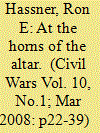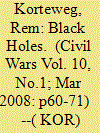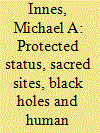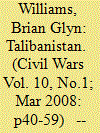|
|
|
Sort Order |
|
|
|
Items / Page
|
|
|
|
|
|
|
| Srl | Item |
| 1 |
ID:
080775


|
|
|
|
|
| Publication |
2008.
|
| Summary/Abstract |
This paper examines the origins and development of the sanctuary practice in Judaism, Christianity and Islam. The customs and laws relating to the sanctuary practice underwent a process of institutionalization that exemplified a constant tension between religious authorities, who wished to expand the practice, and secular authorities, who wished to eliminate it. This struggle resulted in an accommodation: the adoption of rules that restrict the practice in space, scope and duration. Contemporary leaders can draw on these rules to confront the challenges posed by insurgents who appeal for the right of sanctuary. Specifically, secular leaders can rely on these rules to reduce the insurgents' freedom of movement, to demand the expulsion of insurgents from sacred sites, and to attempt the peaceful resolution of standoffs with insurgents who seek prolonged refuge in sacred sites.
|
|
|
|
|
|
|
|
|
|
|
|
|
|
|
|
| 2 |
ID:
080777


|
|
|
|
|
| Publication |
2008.
|
| Summary/Abstract |
The 9/11 attacks demonstrated the strategic importance of terrorist sanctuaries. Aside from sanctuaries provided by host-states, ungoverned areas around the world are exploited by terrorist organizations resulting in terrorist black holes. This article explores the synergy between ungoverned areas and terrorist groups. State failure is not sufficient to explain the creation of these black holes, specific comparative advantages of an area to attract terrorist groups must be taken into account. Seven elements of comparative advantage are introduced of which lack of governmental control is salient. Finally, the possibility of terrorist black holes existing in the West is assessed
|
|
|
|
|
|
|
|
|
|
|
|
|
|
|
|
| 3 |
ID:
080773


|
|
|
|
|
| Publication |
2008.
|
| Summary/Abstract |
The rhetoric following 11 September 2001 was full of talk of operations and battles that would be fought out of the public view, in an effort to prepare voting publics for a conflict of indeterminate scope, duration, and indeed, of place. Locational issues were quickly made central to the new war. 'Sanctuaries', 'safe havens', 'operating environments', 'enabling environments': these were the buzzwords for the long war. They were not new terms of reference, however. Conceptually, sanctuary implies a complex terrain composed of numerous paradigms, correlates, and characteristics. There is also a long and rich history of sanctuary concepts and practices, the lessons of which suggest that perhaps it is more appropriate to think of the issues not in terms of static, grid-referenced points on a map, but as systemic gaps, cracks, elisions, or voids - or perhaps as a series of evolving perspectives, processes and conditions
|
|
|
|
|
|
|
|
|
|
|
|
|
|
|
|
| 4 |
ID:
080774


|
|
|
|
|
| Publication |
2008.
|
| Summary/Abstract |
In recent years, it has been widely argued that a new and different armament - i.e., the refugee as weapon - has entered the world's arsenals. But just how new and different is this weapon? Can it only be used in wartime? And just how successful has been its exploitation? Using a combination of statistical data and case study analysis, this article tackles these questions and provides a detailed examination of the instrumental manipulation of population movements as political and military weapons of war. In addition to 'mapping the terrain' of the issue by providing a comprehensive typology of the most common means by - and desired ends for - which displaced persons have been used as political and military weapons since the end of the Cold War, the author also provides a portrait of the identities of the kinds of actors most likely to engage in this kind of exploitation. She also proposes an explanation for what motivates them to resort - and apparently increasingly so - to the use of this unconventional policy tool, despite the reputational and potential retributive costs of doing so.
|
|
|
|
|
|
|
|
|
|
|
|
|
|
|
|
| 5 |
ID:
080776


|
|
|
|
|
| Publication |
2008.
|
| Summary/Abstract |
This article traces the movement of foreign jihadis to the Pashtun tribal lands situated on the volatile Pakistani-Afghan border from the time of the CIA-sponsored Operation 'Cyclone' to the re-emergence of the Taliban in 2006-2007. The role of autonomous jihadi groups such as the Kashmiri parties, Uighurs, Chechens, Islamic Movement of Uzbekistan as well as the neo-Taliban insurgents and Al-Qaeda terrorist and 055 fighting forces are also analyzed. The article concludes with an overview of fighting and terror trends and future prospects along the Pakistani-Afghan border
|
|
|
|
|
|
|
|
|
|
|
|
|
|
|
|
|
|
|
|
|